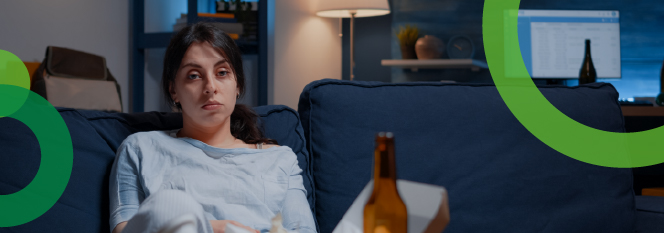What Is Bipolar Disorder? How to Get To Know if I Have It?
Bipolar disorder is a mental health condition that causes extreme changes in a person’s mood, energy, and ability to work. Its key symptoms include; episodes of mania (extremely elevated mood) and episodes of depression (a low mood). Older terms for bipolar disorder are manic depression and bipolar disease.
Bipolar disorder isn't a rare mental illness. According to the National Institute of Mental Health, approximately 2.8% of U.S adults or 5 million people, have bipolar disorder symptoms.
Though bipolar disorder doesn't have a cure, many effective treatments can help you manage mood episodes. These treatments can improve your symptoms and quality of life as well.
Types of Bipolar Disorder
There are three major types of bipolar disorder:
Bipolar I
Bipolar I is caused by the appearance of at least one manic episode. You may experience hypomanic episodes that are less severe than manic episodes. This type of bipolar disorder affects men and women equally.
Bipolar II
People who have bipolar II experience one major depressive episode that remains for at least two weeks. They also suffer from at least one hypomanic episode that lasts for four days. This type of bipolar disorder is usually found in women.
Cyclothymia
People with cyclothymia experience episodes of hypomania and depression. These episodes have less severe and shorter symptoms than mania and depression caused by bipolar type I and bipolar type II. Many people with this mental health condition only experience no mood symptoms for 1 or 2 months.
Bipolar Disorder Symptoms
You must experience at least one period of mania or hypomania to get a diagnosis of bipolar disorder. Both of these include feelings of excitement, impulsivity, and high energy. Mania symptoms can affect your life, leading to problems at home or work. Whereas hypomania symptoms typically don't.
Bipolar I Symptoms
The diagnosis of bipolar I include:
- At least 1 episode of mania that lasts for one week
- Symptoms that affect daily routine
- Symptoms that aren't relevant to medical, mental health conditions, or substance use
Bipolar II Symptoms
The diagnosis of bipolar II requires:
- At least 1 episode of hypomania that lasts for four days or longer and three or more symptoms of hypomania
- Hypomanic-related mood changes that other people can notice, though these may not affect your routine
- At least 1 episode of major depression that lasts two weeks or longer
- At least 1 episode of major depression, including five or more depression symptoms
- Symptoms that don’t relate to another medical, mental health condition, or substance use
Cyclothymia Symptoms
The diagnosis of cyclothymia includes:
- Periods of hypomanic and depression symptoms for over two years or longer
- Signs that never meet the full criteria of hypomania and depression episodes
- Symptoms that affect daily life and cause significant distress
- Symptoms that don’t relate to another medical, mental health condition, or substance use
Bipolar Disorder Symptoms in Females vs Males
Men and women are equally diagnosed with bipolar disorder. However, the key symptoms may vary in both.
Bipolar disorder symptoms in females are:
- Milder episodes of mania
- More depressive episodes
- More co-occurring conditions
On the other hand, males with bipolar disorder may:
- Get a diagnosis earlier in life
- May experience severe but less frequent manic episodes
- Be more likely to have a substance use
- Show more aggression during episodes of mania
Bipolar Disorder in Children and Teens
Diagnosing bipolar disorder in children is controversial because children don't always show the same symptoms as teens. Their moods and behaviours may also not follow the standards therapists use to diagnose the disorder in teens. Many bipolar disorder symptoms in children overlap with other conditions, such as ADHD.
In the last few decades, mental health professionals and doctors have recognized bipolar disorder in children. A proper diagnosis can help children get appropriate treatment, but reaching a diagnosis may require weeks or months. It may be worth seeking care from a certified doctor specializing in treating children with mental health conditions. Like teens, children also have extreme mood shifts while experiencing bipolar disorder.

Bipolar Disorder Treatment
Several bipolar disorder treatments can help you manage signs of bipolar. These include medications, counselling, and some lifestyle changes.
Medications
Recommended medications for bipolar disorder may include:
- Antipsychotics, such as olanzapine
- Mood stabilizers, such as lithium
- Antidepressant-antipsychotics, such as fluoxetine-olanzapine
Psychotherapy
Cognitive Behavioral Therapy (CBT)
CBT is a talk therapy that helps identify and address unwanted thoughts and change behaviour patterns. It offers a safe place to discuss different ways to manage bipolar disorder symptoms. Your therapist can also help you with:
- Understanding thoughts patterns
- Learning and practising coping strategies
Psychoeducation
It is a therapeutic approach that helps you learn about different mental health conditions and their treatment. It can go a long way toward assisting an affected person. Moreover, the people in your life, such as loved ones or friends, can also recognize early mood symptoms and handle the condition efficiently.
Interpersonal and Social Rhythm Therapy
Interpersonal and social rhythm therapy helps regulate daily routines, such as sleeping, eating, and exercising. Maintaining these basics could lead to fewer mood episodes and symptoms.
How Can I Prevent Bipolar Disorder?
Once you start experiencing mood episodes, you can reduce the severity of these episodes and reduce the chances of having additional mood episodes. However, you can't always avoid mood episodes entirely or keep them developing in the first place.
If you’ve noticed bipolar disorder symptoms, your first step should be to contact the doctor as soon as possible. Similarly, if a friend or family member has symptoms, encourage them to consult a therapist in the early stages.
The Bottom Line
Bipolar disorder is a lifelong condition, but it doesn't mean it has to disturb your whole life. When a person experiences bipolar disorder, they might face different challenges. However, sticking with your treatment plan and practising self-care can boost your well-being and keep bipolar disorder symptoms to a minimum.



